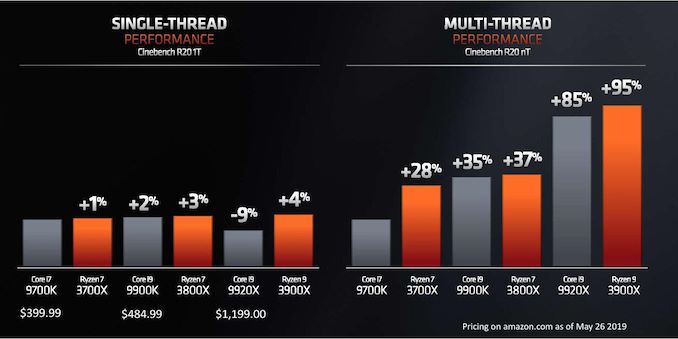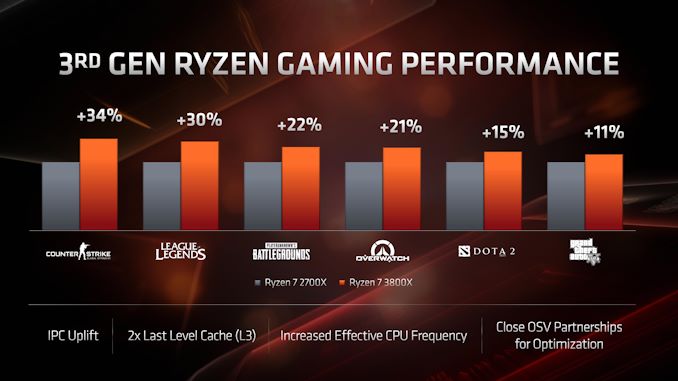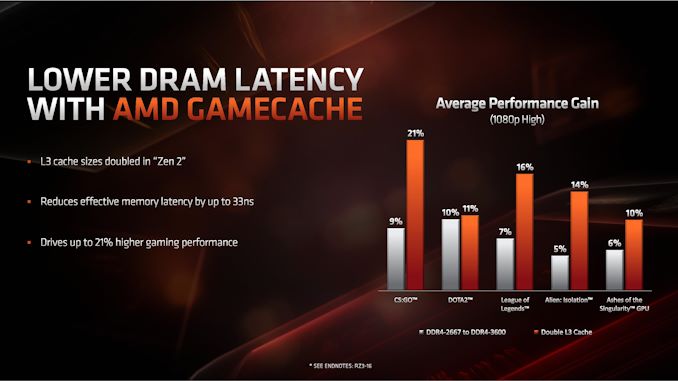AMD Zen 2 Microarchitecture Analysis: Ryzen 3000 and EPYC Rome
by Dr. Ian Cutress on June 10, 2019 7:22 PM EST- Posted in
- CPUs
- AMD
- Ryzen
- EPYC
- Infinity Fabric
- PCIe 4.0
- Zen 2
- Rome
- Ryzen 3000
- Ryzen 3rd Gen
Performance Claims of Zen 2
At Computex, AMD announced that it had designed Zen 2 to offer a direct +15% raw performance gain over its Zen+ platform when comparing two processors at the same frequency. At the same time, AMD also claims that at the same power, Zen 2 will offer greater than a >1.25x performance gain at the same power, or up to half power at the same performance. Combining this together, for select benchmarks, AMD is claiming a +75% performance per watt gain over its previous generation product, and a +45% performance per watt gain over its competition.
These are numbers we can’t verify at this point, as we do not have the products in hand, and when we do the embargo for benchmarking results will lift on July 7th. AMD did spend a good amount of time going through the new changes in the microarchitecture for Zen 2, as well as platform level changes, in order to show how the product has improved over the previous generation.
It should also be noted that at multiple times during AMD’s recent Tech Day, the company stated that they are not interested in going back-and-forth with its primary competition on incremental updates to try and beat one another, which might result in holding technology back. AMD is committed, according to its executives, to pushing the envelope of performance as much as it can every generation, regardless of the competition. Both CEO Dr. Lisa Su, and CTO Mark Papermaster, have said that they expected the timeline of the launch of their Zen 2 portfolio to intersect with a very competitive Intel 10nm product line. Despite this not being the case, the AMD executives stated they are still pushing ahead with their roadmap as planned.
| AMD 'Matisse' Ryzen 3000 Series CPUs | |||||||||||
| AnandTech | Cores Threads |
Base Freq |
Boost Freq |
L2 Cache |
L3 Cache |
PCIe 4.0 |
DDR4 | TDP | Price (SEP) |
||
| Ryzen 9 | 3950X | 16C | 32T | 3.5 | 4.7 | 8 MB | 64 MB | 16+4+4 | 3200 | 105W | $749 |
| Ryzen 9 | 3900X | 12C | 24T | 3.8 | 4.6 | 6 MB | 64 MB | 16+4+4 | 3200 | 105W | $499 |
| Ryzen 7 | 3800X | 8C | 16T | 3.9 | 4.5 | 4 MB | 32 MB | 16+4+4 | 3200 | 105W | $399 |
| Ryzen 7 | 3700X | 8C | 16T | 3.6 | 4.4 | 4 MB | 32 MB | 16+4+4 | 3200 | 65W | $329 |
| Ryzen 5 | 3600X | 6C | 12T | 3.8 | 4.4 | 3 MB | 32 MB | 16+4+4 | 3200 | 95W | $249 |
| Ryzen 5 | 3600 | 6C | 12T | 3.6 | 4.2 | 3 MB | 32 MB | 16+4+4 | 3200 | 65W | $199 |
AMD’s benchmark of choice, when showcasing the performance of its upcoming Matisse processors is Cinebench. Cinebench a floating point benchmark which the company has historically done very well on, and tends to probe the CPU FP performance as well as cache performance, although it ends up often not involving much of the memory subsystem.
Back at CES 2019 in January, AMD showed an un-named 8-core Zen 2 processor against Intel’s high-end 8-core processor, the i9-9900K, on Cinebench R15, where the systems scored about the same result, but with the AMD full system consuming around 1/3 or more less power. For Computex in May, AMD disclosed a lot of the eight and twelve-core details, along with how these chips compare in single and multi-threaded Cinebench R20 results.
AMD is stating that its new processors, when comparing across core counts, offer better single thread performance, better multi-thread performance, at a lower power and a much lower price point when it comes to CPU benchmarks.
When it comes to gaming, AMD is rather bullish on this front. At 1080p, comparing the Ryzen 7 2700X to the Ryzen 7 3800X, AMD is expecting anywhere from a +11% to a +34% increase in frame rates generation to generation.
When it comes to comparing gaming between AMD and Intel processors, AMD stuck to 1080p testing of popular titles, again comparing similar processors for core counts and pricing. In pretty much every comparison, it was a back and forth between the AMD product and the Intel product – AMD would win some, loses some, or draws in others. Here’s the $250 comparison as an example:
Performance in gaming in this case was designed to showcase the frequency and IPC improvements, rather than any benefits from PCIe 4.0. On the frequency side, AMD stated that despite the 7nm die shrink and higher resistivity of the pathways, they were able to extract a higher frequency out of the 7nm TSMC process compared to 14nm and 12nm from Global Foundries.
AMD also made commentary about the new L3 cache design, as it moves from 2 MB/core to 4 MB/core. Doubling the L3 cache, according to AMD, affords an additional +11% to +21% increase in performance at 1080p for gaming with a discrete GPU.
There are some new instructions on Zen 2 that would be able to assist in verifying these numbers.















216 Comments
View All Comments
Targon - Thursday, June 13, 2019 - link
The TDP figures are always a bit vague, because it is about the heat generation, not about power draw. A higher TDP on a chip with the same number of cores on the same design could indicate that it will overclock higher. Intel always sets the TDP to the base clock speed, while AMD has been more about what can be expected in normal usage. The higher the clock speed, the more power will be required, and the higher the amount of heat will be that needs to be handled by the cooler.So, if a chip has a TDP of 105W, then in theory, you should be able to get away with a cooler that can handle 105W of heat output, but if that TDP is based only on the base clock speed, you will want a better cooler to allow for turbo/boost for sustained periods.
wilsonkf - Monday, June 10, 2019 - link
We want faster memory for Zen/Zen+ because we want higher IF clock, so cutting the IF clock by half to enable higher memory freq. does not make sense. However the improved IF could move the bottleneck somewhere else.AlexDaum - Tuesday, June 11, 2019 - link
It seems like IF2 can not hit frequencies higher than about 3733MHz DDR (so 1,8GHz real frequency) for some reason, so they added the ability to scale it down to have higher memory clocks. But it is probably only worth it if you can overclock memory a lot higher than 3733, so that the IF clock gets a bit higher againXyler94 - Tuesday, June 11, 2019 - link
If I recall, IF2's clock speed is decoupled from RAM speed.Cooe - Tuesday, June 11, 2019 - link
This is wrong Xyler. Still completely connected.Xyler94 - Thursday, June 13, 2019 - link
Per this exact Article:"One of the features of IF2 is that the clock has been decoupled from the main DRAM clock. In Zen and Zen+, the IF frequency was coupled to the DRAM frequency, which led to some interesting scenarios where the memory could go a lot faster but the limitations in the IF meant that they were both limited by the lock-step nature of the clock. For Zen 2, AMD has introduced ratios to the IF2, enabling a 1:1 normal ratio or a 2:1 ratio that reduces the IF2 clock in half."
It seems it has been, but it may still benefit from faster RAM still
extide - Monday, June 17, 2019 - link
It is completely connected -- you can just pick a 1:1 or 2:1 divider now but they are absolutely still tightly coupled. YOu can't just set them independently.Cooe - Tuesday, June 11, 2019 - link
You're missing the point for >3733MHz memory overclocked where the IF switches to a 2:1 divider. It's for workloads that highly prioritize memory bandwidth over latency, NOT to try and run your sticks 24/7 at like 5GHz+ for the absolute lowest latency possible (bc even then, 3733MHz will prolly still be lower).Targon - Thursday, June 13, 2019 - link
From what I remember, up to DDR4-3733, Infinity Fabric on Ryzen 3rd generation is now at a 1:1(where previously, Infinity Fabric would run at half the DDR4 speed. You can go above that, but then the improvements are not going to be as significant. For latency, your best bet is to get 3733 or 3600 with as low a CAS rating as you can get.zodiacfml - Tuesday, June 11, 2019 - link
that 105W TDP is a sign that the 8 core is efficient at 50W or a base clock of 3.5 GHz. The AMD 7nm 8-Core Zen 2 chip has a TDP equal or less than my i3-8100.😅